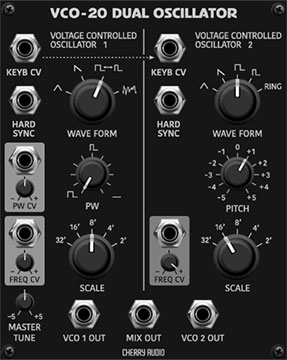VCO-20 accurately replicates the tone and functionality of a classic 70s Japanese monosynth, including all waveforms and a white noise source. It also adds CV-controllable pulse width on VCO 1, and hard sync inputs for both oscillators. Because of its unique waveforms (i.e. not-exactly correct), it's the perfect companion for the VCF-20 Filter module.
Since VCO-20 contains two independent oscillators, we'll go over the repeated controls and I/O one time, because you're smart, and we don't like typing!
Inputs, Outputs, and Controls
Pitch CV jack- Accepts a CV input for pitch. Typically this would come from the Pitch jack in the IO Panel CV Out section, or from a sequencer pitch CV out. Patching a cable to the Pitch CV input on the VCO 1 side automatically connects to the VCO 2 Pitch CV input if nothing is plugged into VCO 2's Pitch CV input (that's what the horizontal arrow is showing). Patching a cable into VCO 2 Pitch CV breaks the normalled connection and lets the Pitch CV inputs function independently.
Hard Sync jack- Force resets the start of the waveform to the beginning of its cycle. Most often used to create the "sync sweep" oscillator sounds made famous in The Cars' "Let's Go" (or Kraftwerk's "Neon Lights" and No Doubt's "Just A Girl"), by routing the output of one oscillator to the other's Hard Sync input and sweeping the pitch of the first oscillator.
Wave Form- Yes, we incorrectly split the word in half, just like the real synth. This selects the waveform for each oscillator.
VCO 1 pulse position has a variable duty-cycle (i.e. width), adjusted by the PW knob. The jaggedy wave in the last position of VCO 1 indicates white noise.
VCO 2 has two fixed pulse waves - square and narrow. The Ring position enables ring modulation between the two oscillators. It won't affect the VCO 1 Out, but you'll hear it in both the Mix Out and VCO 2 Out. It's actually not a true, technically correct ring modulator - the engineers of the original synth used a common-for-the-era method of achieving a very similar effect, and it sounds pretty wicked! It's most audible when using wide pitch spreads between the oscillators and mucking with VCO 2's Pitch knob (or modulating via VCO 2's Freq CV mod input if you're one of them fancy types).
PW (VCO 1 only)- Sets the width of VCO 1's pulse wave, from a perfect square to a very narrow pulse. It has no effect on other waveforms.
Master Tune (VCO 1 only)- This is situated on the VCO 1 side, but it affects tuning for both oscillators, up or down about a fourth.
Scale- Sets the basic pitch of the oscillator, displayed in traditional organ footage, i.e. larger number equals lower pitch.
Pitch (VCO 2 only)- Detunes VCO 2 independently of VCO 1. The front panel of the original MS-20 is labeled -5 to +5, but its range was actually around an octave either way, so we've done the same here - VCO-20's detune range is just over an octave up or down. Detune can be used for subtle "fattening," or setting note intervals between the two oscillators for hideous prog rock soloing (or other less offensive uses).
PW CV Mod jack- You may have noticed that moving the PW knob back and forth creates a nifty sound; instead of wearing out your mouse hand, the PW CV input can be used in conjunction with an LFO, envelope generator, or other mod source to continuously vary the pulse width. Note that the attenuator knob is bipolar, i.e. "zero" position is center. Turning right adds a positive modulation, turning left inverts the incoming CV.
Freq CV Mod jack- Allows modulation of oscillator pitch.
VCO 1 Out / VCO 2 Out- Independent outputs for each oscillator.
Mix Out- Outputs an equal, 50/50 mix of both oscillators. For finer control of oscillator mix level, patch the individual outputs to a mixer module.
